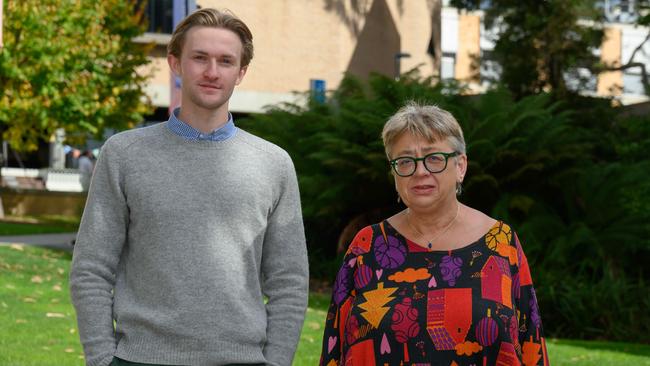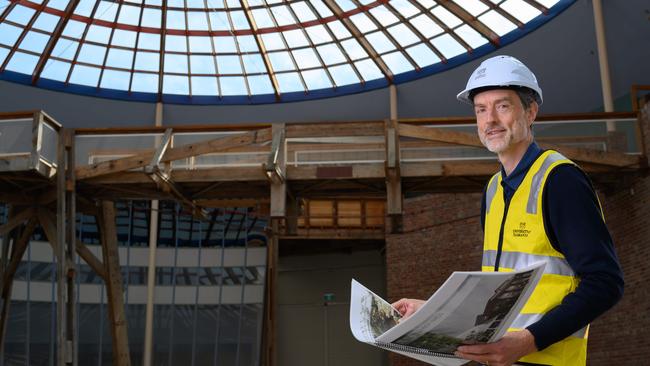VC warns UTAS move vital for ‘viability’ but faces growing revolt, key defection
University of Tasmania has warned its viability depends on shifting its Hobart campus to the CBD, amid calls for an independent inquiry and the defection of a key political backer.

University of Tasmania has warned its viability depends on shifting its Hobart campus to the CBD, amid calls for an independent inquiry and the defection of a key political backer.
In an Australian first, one of the nation’s oldest universities will largely abandon its established Sandy Bay campus and develop the valuable land for 2700 homes.
The proceeds will fund a $550m move to buildings in five CBD precincts – a transformation UTAS says will boost student access but opponents claim signals a destruction of the traditional university.
Vice-chancellor Rufus Black said, while improving access to the university was the key driver, the move was also vital to its viability. Seeking to provide a wide range of courses for a small population across three cities, UTAS needed the “endowment” the housing development would provide.

“Americans created land-grant universities, where they recognise that university long-term viability depends on having some kind of endowment,” Professor Black said. “This endowment will enable us to deliver education to Tasmanians.”
He revealed the extensive Sandy Bay site was valued at “ballpark $750m”. UTAS would develop the land for housing but retain ownership, offering 99-year leases, providing ongoing revenue.
However, a campaign to stop the CBD shift – by academics, students, alumni and residents – appears to be gaining momentum.
UTAS has bought new CBD buildings but is yet to win planning approval to rezone the old campus as residential to allow for the mostly apartment-style homes.
Key players across the political divide are joining the revolt, the latest being independent MP for Hobart-based Clark, Andrew Wilkie. A former supporter of the shift, Mr Wilkie said his backing had been contingent on UTAS addressing concerns over traffic, parking and amenity. “Those concerns haven’t been addressed and so, at this point in time, I am not supportive,” Mr Wilkie said.
If the local planning process was not transparent or comprehensive, he would back “an independent inquiry”.
“I am attracted to the concept of a university city, but it’s got to be done right and it hasn’t been done right up until now,” Mr Wilkie said.
Liberal senator Eric Abetz has requested a federal Auditor-General’s probe. “Future generations will ask … why such an idyllic campus was forfeited for a sterile concrete and asphalt jungle which will undo the whole concept of university life,” Mr Abetz said.
Professor Black warned if the rezoning was blocked, it was not an option for UTAS to sell the CBD buildings to instead fund an upgrade of the Sandy Bay campus.
“The numbers just absolutely don’t add up,” he said. “If we were to sell all of the city buildings we don’t currently use … it would (raise) barely $100m. Against a half-billion rebuild cost in Sandy Bay, it doesn’t touch the sides.”
Many of the Sandy Bay buildings dated from the 1950s and were no longer fit for purpose or fully used, he said.
However, Save UTAS Campus, which claims 5000 members, accuses UTAS of exaggerating the cost of refurbishing the Sandy Bay buildings. Spokeswoman, former UTAS history professor Pam Sharpe, said the CBD move showed UTAS had “lost its way”, with “authoritarian” management presiding over “declining standards”.
Professor Sharpe said UTAS was “winging it”, gambling on the Sandy Bay rezoning. “Everything could fall apart,” she said.
“I think they could go completely bankrupt and maybe then be taken over by a mainland university. We need an independent review of what is proposed that looks at the big picture.”
Law student Fletcher Clarke, president of the Tasmania University Law Society, said the CBD move was “all about a massive downsizing, reducing overheads and costs and encouraging people to study from home”.
Professor Black said a third of students were already in city-based UTAS faculties, and while full relocation meant a reduced footprint, face-to-face teaching would continue.







To join the conversation, please log in. Don't have an account? Register
Join the conversation, you are commenting as Logout